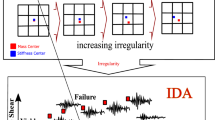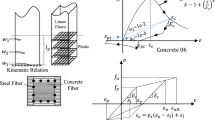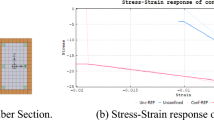Abstract
Post-earthquake surveys indicate that losses come from non-structural damage more than from structural damage. Current performance-based design would prevent excessive non-structural damage as well, but the effectiveness of relevant code provisions has not been assessed in depth. This study investigates the drift-sensitive non-structural damage to reinforced concrete frame buildings complying with the European seismic code. Damage to non-structural unreinforced masonry infill walls in contact with the frame is quantified in terms of numerical fragility curves with the same quantities considered in the design: the peak ground acceleration measures the seismic intensity; the peak value of the interstorey drift ratio is the damage index. The methodology for the fragility computation is described in detail. Peculiar is the use of probabilistic parameters of the drift capacity coupled to the fuzziness in the damage state. The drift demand is estimated by member-by-member modelling of typical frame structures and non-linear time–history analyses under spectrum-compatible artificial accelerograms. The kind of the infills and their modelling, the number of storeys, the ground type, and the ductility class are covered. Modelling the infills results to be essential. Any code-compliant verification is on the safe side, but the margin appears to be inconsistent among the frames under consideration. Furthermore, there is one case where occupancy appears to be not ensured despite the code verification is satisfied. The effect of the number of storeys may be misrepresented. The ductility class may be unimportant, however the damage seems to be correlated with the likely strength.















Similar content being viewed by others
References
Augenti N, Parisi F (2010) Learning from construction failures due to the 2009 L’Aquila, Italy, earthquake. J Perform Constr Facil 24(6):536–555. doi:10.1061/(ASCE)CF.1943-5509.0000122
Bommer JJ, Magenes G, Hancock J, Penazzo P (2004) The influence of strong-motion duration on the seismic response of masonry structures. Bull Earthq Eng 2(1):1–26. doi:10.1023/B:BEEE.0000038948.95616.bf
Braga F, Manfredi V, Masi A, Salvatori A, Vona M (2011) Performance of non-structural elements in RC buildings during the L’Aquila, 2009 earthquake. Bull Earthq Eng 9(1):307–324. doi:10.1007/s10518-010-9205-7
Calvi GM (1999) A displacement-based approach for vulnerability evaluation of classes of buildings. J Earthq Eng 3(3):411–438. doi:10.1080/13632469909350353
CEN (2002a) EN 1990 Eurocode: basis of structural design. European Committee for Standardization, Brussels
CEN (2002b) EN 1991-1-1 Eurocode 1: actions on structures-Part 1–1: general actions. European Committee for Standardization, Brussels
CEN (2004a) EN 1992 Eurocode 2: design of concrete structures. European Committee for Standardization, Brussels
CEN (2004b) EN 1998-1 Eurocode 8: design of structures for earthquake resistance-Part 1: general rules, seismic actions and rules for buildings. European Committee for Standardization, Brussels
CEN (2005) EN 1998-3 Eurocode 8: design of structures for earthquake resistance-Part 3: assessment and retrofitting of buildings. European Committee for Standardization, Brussels
CM 617 (2009) Istruzioni per l’applicazione delle nuove norme tecniche per le costruzioni. Ministero delle Infrastrutture e dei Trasporti, Rome (in Italian)
Colangelo F (2003) Experimental evaluation of member-by-member models and damage indices for infilled frames. J Earthq Eng 7(1):25–50. doi:10.1142/S1363246903000821
Colangelo F (2005) Pseudo-dynamic seismic response of reinforced concrete frames infilled with non-structural brick masonry. Earthq Eng Struct Dyn 34(10):1219–1241. doi:10.1002/eqe.477
Colangelo F (2012) A simple model to include fuzziness in the seismic fragility curve and relevant effect compared with randomness. Earthq Eng Struct Dyn 41(5):969–986. doi:10.1002/eqe.1169
Colangelo F (2013) Probabilistic characterisation of an analytical fuzzy-random model for seismic fragility computation. Struct Safety 40:68–77. doi:10.1016/j.strusafe.2012.09.008
Colangelo F, Stornelli P (2008) Seismic damage of nonstructural masonry infills: statistical characterization by interstory drift and stiffness decrease. In: Proceedings of the 8th US national conference on earthquake engineering, paper 821
DM 14/1/2008 (2008) Norme tecniche per le costruzioni. Ministero delle Infrastrutture e dei Trasporti, Rome (in Italian)
Draper NR, Smith H (1998) Applied regression analysis, 3rd edn. Wiley, New York
Dymiotis C, Kappos AJ, Chryssanthopoulos MK (1999) Seismic reliability of RC frames with uncertain drift and member capacity. J Struct Eng 125(9):1038–1047. doi:10.1061/(ASCE)0733-9445(1999)125:9(1038)
Fardis MN, Papailia A, Tsionis G (2012) Seismic fragility of RC framed and wall-frame buildings designed to the EN-Eurocodes. Bull Earthq Eng 10(6):1767–1793. doi:10.1007/s10518-012-9379-2
FEMA (2000) Prestandard and commentary for the seismic rehabilitation of buildings. Report FEMA 356, Federal Emergency Management Agency, Washington
FEMA (2003) Multi-hazard loss estimation methodology-Earthquake model HAZUS-MH MR4 technical manual. Federal Emergency Management Agency, Washington
Ghobarah A (2004) On drift limits associated with different damage levels. In: Fajfar P, Krawinkler H (eds) Performance-based seismic design concepts and implementation. PEER report 2004/05, Pacific Earthquake Engineering Research Center, Berkeley, pp 321–332
Gu X, Lu Y (2005) A fuzzy–random analysis model for seismic performance of framed structures incorporating structural and non-structural damage. Earthq Eng Struct Dyn 34(10):1305–1321. doi:10.1002/eqe.481
Hill M, Rossetto T (2008) Comparison of building damage scales and damage descriptions for use in earthquake loss modelling in Europe. Bull Earthq Eng 6(2):335–365. doi:10.1007/s10518-007-9057-y
Iervolino I, Manfredi G, Cosenza E (2006) Ground motion duration effects on nonlinear seismic response. Earthq Eng Struct Dyn 35(1):21–38. doi:10.1002/eqe.529
Litton RW (1975) A contribution to the analysis of concrete structures under cyclic loading. PhD thesis, Department of Civil Engineering, University of California, Berkeley
Lu Y, Gu XM (2004) Probability analysis of RC member deformation limits for different performance levels and reliability of their deterministic calculations. Struct Safety 26(4):367–389. doi:10.1016/j.strusafe.2004.01.001
Masi A (2003) Seismic vulnerability assessment of gravity load resigned R/C frames. Bull Earthq Eng 1(3):371–395. doi:10.1023/B:BEEE.0000021426.31223.60
Mondkar DP, Powell GH (1975a) Static and dynamic analysis of nonlinear structures. Report UCB/EERC-75/10, Earthquake Engineering Research Center, University of California, Berkeley
Mondkar DP, Powell GH (1975b) ANSR-I: general purpose program for analysis of nonlinear structural response. Report UCB/EERC-75/37, Earthquake Engineering Research Center, University of California, Berkeley
Mosalam KM, Ayala G, White RN, Roth C (1997) Seismic fragility of LRC frames with and without masonry infill walls. J Earthq Eng 1(4):693–720. doi:10.1142/S1363246997000271
Ólafsson S, Sigbjörnsson R (2011) Digital filters for simulation of seismic ground motion and structural response. J Earthq Eng 15(8):1212–1237. doi:10.1080/13632469.2011.565862
Otani A (1974) Inelastic analysis of reinforced concrete frame structures. J Struct Div 100(ST7):1433–1449
Özcebe S, Crowley H, Bal IE (2012) Distinction between no and slight damage states for existing RC buildings using a displacement-based approach. In: Proceedings of the 15th world conference on earthquake engineering, paper 5126.
Panagiotakos TB, Fardis MN (1997) Infill macromodel developed at the University of Patras. In: Fardis MN (ed) Experimental and numerical investigations on the seismic response of RC infilled frames and recommendations for code provisions. Report 6 of PREC8/ECOEST projects, Laboratório Nacional de Engenharia Civil, Lisbon
Press WH, Teukolsky SA, Vetterling WT, Flannery BP (2007) Numerical recipes: the art of scientific computing, 3rd edn. Cambridge University Press, Cambridge
Ricci P, De Risi MT, Verderame GM, Manfredi G (2012) Influence of infill presence and design typology on seismic performance of RC buildings: fragility analysis and evaluation of code provisions at damage limitation limit state. In: Proceedings of the 15th world conference on earthquake engineering, paper 5836
Rivera JA, Petrini L (2011) On the design and seismic response of RC frame buildings designed with Eurocode 8. Bull Earthq Eng 9(5):1593–1616. doi:10.1007/s10518-011-9290-2
Rossetto T, Elnashai A (2003) Derivation of vulnerability functions for European-type RC structures based on observational data. Eng Struct 25(10):1241–1263. doi:10.1016/S0141-0296(03)00060-9
Rozman M, Fajfar P (2009) Seismic response of a RC frame building designed according to old and modern practices. Bull Earthq Eng 7(3):779–799. doi:10.1007/s10518-009-9119-4
Saaty TL (2008) Relative measurement and its generalization in decision making; why pairwise comparisons are central in mathematics for the measurement of intangible factors; the analytic hierarchy/network process. Rev R Acad Cien Serie A Mat 102(2):251–318. doi:10.1007/BF03191825
Shinozuka M, Deodatis G (1991) Simulation of stochastic processes by spectral representation. Appl Mech Rev 44(4):191–204. doi:10.1115/1.3119501
Soong TT (2004) Fundamentals of probability and statistics for engineers. Wiley, Chichester
Taghavi S, Miranda E (2003) Response assessment of nonstructural building elements. PEER report 2003/05, Pacific Earthquake Engineering Research Center, Berkeley.
Takeda T, Sozen MA, Nielsen NN (1970) Reinforced concrete response to simulated earthquakes. J Struct Div 96(ST12):2557–2573
Vanmarcke EH (1976) Structural response to earthquakes. In: Lomnitz C, Rosenblueth E (eds) Seismic risk and engineering decisions. Elsevier, Amsterdam, pp 287–337
Vanmarcke EH, Cornell CA, Gasparini DA, Hou SN (1976) Simulation of earthquake ground motions. Department of Civil Engineering, Massachusetts Institute of Technology, Cambridge
Yuan X-X, Pandey MD (2006) Analysis of approximations for multinormal integration in system reliability computation. Struct Safety 28(4):361–377. doi:10.1016/j.strusafe.2005.10.002
Zadeh LA (1968) Probability measures of fuzzy events. J Math Anal Appl 23(2):421–427. doi:10.1016/0022-247X(68)90078-4
Zovkic J, Sigmund V, Guljas I (2013) Cyclic testing of single bay reinforced concrete frames with various types of masonry infill. Earthq Eng Struct Dyn 42(8):1131–1149. doi:10.1002/eqe.2263
Acknowledgments
This study was partly funded by the Italian Ministry of Education, University, and Research (MIUR) with Grant No. 2010MBJK5B_006.
Author information
Authors and Affiliations
Corresponding author
Rights and permissions
About this article
Cite this article
Colangelo, F. Drift-sensitive non-structural damage to masonry-infilled reinforced concrete frames designed to Eurocode 8. Bull Earthquake Eng 11, 2151–2176 (2013). https://doi.org/10.1007/s10518-013-9503-y
Received:
Accepted:
Published:
Issue Date:
DOI: https://doi.org/10.1007/s10518-013-9503-y




